The Coordinated Relationship between Investment Potential and Economic Development and Its Driving Mechanism: A Case Study of the African Region
Abstract
1. Introduction
2. Research Methods and Data
2.1. The Index System and Data Sources
2.2. Methods
2.2.1. Entropy Weight Method
2.2.2. Coupling Coordination Degree Model
2.2.3. Exploratory Spatial Data Analysis
2.2.4. Geographic Detector
2.2.5. Geographically Weighted Regression Model
3. Results
3.1. Dynamic Evolution of Investment Potential and Economic Development: 2008, 2012, and 2016
3.2. Spatial Differentiation Characteristics of the Coordinated Relationship between Investment Potential and Economic Development in Africa: 2008, 2012, and 2016
3.2.1. Classification of Coordinated Relationship between Investment Potential and Economic Development
3.2.2. Analysis of the Spatio-Temporal Pattern of the Coordinated Relationship between Investment Potential and Economic Development
3.3. The Driving Mechanism of the Coordinated Relationship between Investment Potential and Economic Development in Africa
3.3.1. The Analysis of Driving Factors Based on Geographic Detector
3.3.2. Geographically Weighted Regression Analysis of Driving Factors
- The regression coefficient for economic base had been decreasing gradually but remained one of the most influential driving factors. In 2008, the economic base had a significant impact on the coordination degree for Ethiopia, Sudan, Egypt, Tunisia, Eritrea, and other countries in the northeast. From 2012 to 2016, the high-value distribution area shifted gradually to Southeastern Africa, and Madagascar became an economic base driven country.
- The spatial distribution of the regression coefficient for industrial construction showed significant changes. In 2008, the industrial construction level was a vital driving force for improving coordination in Algeria, Morocco, Tunisia, Mauritania, and Senegal. In 2012, a large number of countries in southern Africa became a country of industry-driven. In 2016, the high-value area of the regression coefficient contracted to the north. In the end, the coordination degree of only Algeria, Morocco, and Tunisia was strongly driven by the industrial construction level.
- The change in regression coefficient for information support level can be characterized as having an east–west configuration, where the high-value areas are found on the eastern side of the continent the regression coefficient decrease gradually when moving westwards. Ethiopia and Madagascar were found to be significantly affected by the information support level and are categorized as being information application-driven economies.
- From 2008 to 2016, the regression coefficients appeared to have the morphological characteristics of decreasing from northwest to southeast; the areas with highest regression coefficients for business friendliness were found in northwest Africa (e.g., Morocco, Mauritius, Senegal, and Cape Verde). Business friendliness is an essential driving factor to promote improvements in the coordination relations in these countries, which can be categorized as being the business convenience-driven type. At the same time, Southeast African countries must actively pursue more spillover benefits from a business conducive environment.
- Over time, the regression coefficient for the residents’ living standards has changed from negative to positive, and the positive effect of this variable has substantially increased. High regression coefficient areas for this variable gradually extended from Liberia, Côte d’Ivoire, Guinea, Guinea-Bissau, and Senegal into Morocco, Cape Verde, and Mauritania. The changes in the residents’ consumption capability, product demand level, and consumer market have a vital role in promoting the coordination relationship, particularly in Africa’s northwestern region, which can be considered as being consumer market-driven.
4. Discussion
4.1. Evaluation of Investment Potential and Economic Development
4.2. The Evolution of the Coordinated Relationship between Investment Potential and Economic Development
4.3. The Driving Mechanism of the Coordinated Relationship between Investment Potential and Economic Development
4.4. Limitations of the Study
5. Conclusions
- We found that the spatial distribution of high-level countries has strong similarities in terms of investment potential and economic development. The overall investment potential of African countries was found to be weak, but the internal differences in investment potential have gradually narrowed. The overall economic level is rising steadily, but the “economic gap” between countries is still very evident.
- The coordinated relationship between investment potential and economic development can be divided into three categories: uncoordinated development, barely coordinated development, and coordinated development. Uncoordinated development and barely coordinated development were the most dominant types of coordinated relationship. By determining the lag conditions, countries can adopt unique strategies in order to attract foreign investments. The coordinated relationship between investment potential and economic development in African countries showcased attributes of spatial agglomeration. Hot spot areas were characterized by condensed and continuous distributions as the overall pattern while the local area had fragmented distributions; a hot spot agglomeration was found in Southern Africa. For cold spot areas, a spatial distribution pattern of “one core and one belt” was formed, with some Western African countries become part of the core area and some Central and Eastern African countries constituting the belt.
- Economic base, residents’ living standard, industrial construction level, information support level, and business friendliness were the leading indicators in the relationship between investment potential and economic development. The distribution of regression coefficients showed distinct spatial heterogeneity. According to the distribution of regression coefficients in various countries, the driving mechanism of the coordination relationship can be divided into five types: economic base driven, industry-driven, information application-driven, business convenience-driven, and consumer market-driven.
Author Contributions
Funding
Acknowledgments
Conflicts of Interest
References
- Ezcurra, R. Does Economic Globalization affect Regional Inequality? A Cross-country Analysis. World Dev. 2013, 52, 92–103. [Google Scholar] [CrossRef]
- Vogli, R.D.; Kouvonen, A.; Elovainio, M.; Marmot, M. Economic globalization, inequality and body mass index: A cross-national analysis of 127 countries. Crit. Public Health 2014, 24, 15. [Google Scholar] [CrossRef]
- Samimi, P.; Jenatabadi, H.S. Globalization and economic growth: Empirical evidence on the role of complementarities. PLoS ONE 2014, 9, e87824. [Google Scholar] [CrossRef]
- Yang, W.L.; Du, D.B.; You, X.J.; Shi, W.T.; Yan, Z.M. Network Structure Evolution and Spatial Complexity of Global Transnational Investment. Sci. Geogr. Sin. 2017, 37, 1300–1309. [Google Scholar]
- Radice, H. Transnational corporations and global capitalism: Reflections on the last 40 years. Crit. Perspect. Int. Bus. 2014, 10, 21–34. [Google Scholar] [CrossRef]
- Chen, Y.; Chai, H.; Huang, Y. Based on Fuzzy Comprehensive Evaluation Method The Investment Risk Assessment of Chinese Enterprises in The Countries Along ng ntries AlonRoadng. IOP Conf. Ser. Earth Environ. Sci. 2018, 108, 042073. [Google Scholar] [CrossRef]
- Junkes, M.B.; Tereso, A.P.; Afonso, P.S.L.P. The Importance of Risk Assessment in the Context of Investment Project Management: A Case Study. Procedia Comput. Sci. 2015, 64, 902–910. [Google Scholar] [CrossRef]
- Ge, S.J.; Shi, A.N. Construction of the Factors Affecting China′s Hydropower Projects and Overseas Investment Risk Assessment Index System. Appl. Mech. Mater. 2014, 672, 2077–2084. [Google Scholar] [CrossRef]
- Fang, Y.N. Risk Assessment of Chinese Enterprises to Overseas Direct Investment Countries under the “Belt and Road” Strategy. Discuss. Mod. Econ. 2016, 1, 79–83. [Google Scholar]
- Ding, L.; Zhao, W.T.; Huang, Y.L.; Cheng, S.G.; Liu, C. Research on the Coupling Coordination Relationship between Urbanization and the Air Environment: A Case Study of the Area of Wuhan. Atmosphere 2015, 6, 1539–1558. [Google Scholar] [CrossRef]
- Zhang, C.M.; Zhang, X.L.; Wu, Q.Y.; Li, H.B. The Coordination About Quality and Scale of Urbanization:Case Study of Jiangsu Province. Sci. Geogr. Sin. 2013, 33, 16–22. [Google Scholar]
- Ji, C.; Zhanqi, W.; Hongwei, Z. Integrated Evaluation of Coupling Coordination for Land Use Change and Ecological Security: A Case Study in Wuhan City of Hubei Province, China. Int. J. Environ. Res. Public Health 2017, 14, 1435–1450. [Google Scholar]
- Wang, Y.H.; Yuan, Y.; Wang, Y.L.; Zhang, X.L.; Qiao, W.F. Relationship and mechanism of coupling development between population and land urbanization: A case study of Jiangsu province. Geogr. Res. 2017, 36, 149–160. [Google Scholar]
- Wang, Y.H. Empirical Study of the Coupling Coordination Relationship of urbanization and ecological environment in Nanchang and Jiujiang urban belts. J. Interdiscip. Math. 2014, 17, 516–526. [Google Scholar]
- Wang, S.J.; Ma, H.; Zhao, Y.B. Exploring the relationship between urbanization and the eco-environment-A case study of Beijing-Tianjin-Hebei region. Ecol. Indic. 2014, 45, 171–183. [Google Scholar] [CrossRef]
- Mhlanga, N.; Blalock, G.; Christy, R.D. Understanding Foreign Direct Investment in the Southern African Development Community: An Analysis Based on Project-Level Data. Agric. Econ. 2010, 41, 337–347. [Google Scholar] [CrossRef]
- Ampiah, K.; Rose, C. The Evolving Relations between Japan and Africa: The Discourse of the Tokyo International Conference on African Development (TICAD). Jpn. Stud. 2012, 32, 153–159. [Google Scholar] [CrossRef]
- Li, S.; Ying, Z.X.; Zhang, H. Comprehensive assessment of urbanization coordination: A case study of Jiangxi province, China. Chin. Geogr. Sci. 2019, 29, 128–142. [Google Scholar] [CrossRef]
- Li, M.C.; Mao, C.M. Spatial-Temporal Variance of Coupling Relationship between Population Modernization and Eco-Environment in Beijing-Tianjin-Hebei. Sustainability 2019, 4, 991. [Google Scholar] [CrossRef]
- He, J.Q.; Wang, S.J.; Liu, Y.Y.; Ma, H.T.; Liu, Q.Q. Examining the relationship between urbanization and the eco-environment using a coupling analysis: Case study of Shanghai, China. Ecol. Indic. 2017, 77, 185–193. [Google Scholar] [CrossRef]
- Yao, L.; Li, X.L.; Li, Q.; Wang, J.K. Temporal and Spatial Changes in Coupling and Coordinating Degree of New Urbanization and Ecological-Environmental Stress in China. Sustainability 2019, 4, 1171. [Google Scholar] [CrossRef]
- Wang, J.F.; Xu, C.D. Geographic detector: Principle and Prospect. Acta Geogr. Sin. 2017, 72, 116–134. [Google Scholar]
- Xu, B.; Xu, L.; Xu, R.J.; Luo, L.Q. Geographical analysis of CO2 emissions in China’s manufacturing industry: A geographically weighted regression model. J. Clean. Product. 2017, 26, 173–187. [Google Scholar] [CrossRef]
- Wang, F.X.; Mao, A.H.; Li, H.L.; Jia, M.L. Quality Measurement and Regional Difference of Urbanization in Shandong Province Based on the Entropy Method. Sci. Geogr. Sin. 2013, 33, 1323–1329. [Google Scholar]
- Xie, S.H.; Gan, C.; Wang, Q. The Comprehensive Evaluation of the Investment Environment of the African Countries and the Analysis of the Spatial Difference. Econ. Geogr. 2017, 37, 10–16. [Google Scholar]
- Jiang, D.L.; Yang, D.; Ren, Z.P.; Chen, Y.Y.; Zhang, Z.K. Evaluation of Comprehensive Economic and Social Development level in Africa based on TOPSIS method. Trop. Geogr. 2015, 35, 242–249. [Google Scholar]
- Song, Q.J.; Zhou, N.; Liu, T.L.; Siehr, S.A.; Qi, L. Investigation of a “coupling model” of coordination between low-carbon development and urbanization in China. Energy Policy. 2018, 121, 346–354. [Google Scholar] [CrossRef]
- Lu, C.Y.; Yang, J.Q.; Li, H.J.; Jing, S.L.; Pang, M.; Lu, C.P. Research on the Spatial-Temporal Synthetic Measurement of the Coordinated Development of Population-Economy-Society-Resource-Environment (PESRE) Systems in China Based on Geographic Information Systems (GIS). Sustainability 2019, 10, 2877. [Google Scholar] [CrossRef]
- Xu, J.G.; Yin, H.W.; Zhong, G.F.; Zeng, Z.G. African Economic pattern based on Spatial autocorrelation. Econ. Geogr. 2006, 26, 771–775. [Google Scholar]
- Cai, B.B.; Zhao, W.; Li, Y.H.; Li, Z.Y. Spatial pattern and influencing factors of Coupling and Coordination between Regional Innovation and Regional economy in China. Res. Sci. Technol. Manag. 2019, 10, 96–105. [Google Scholar]
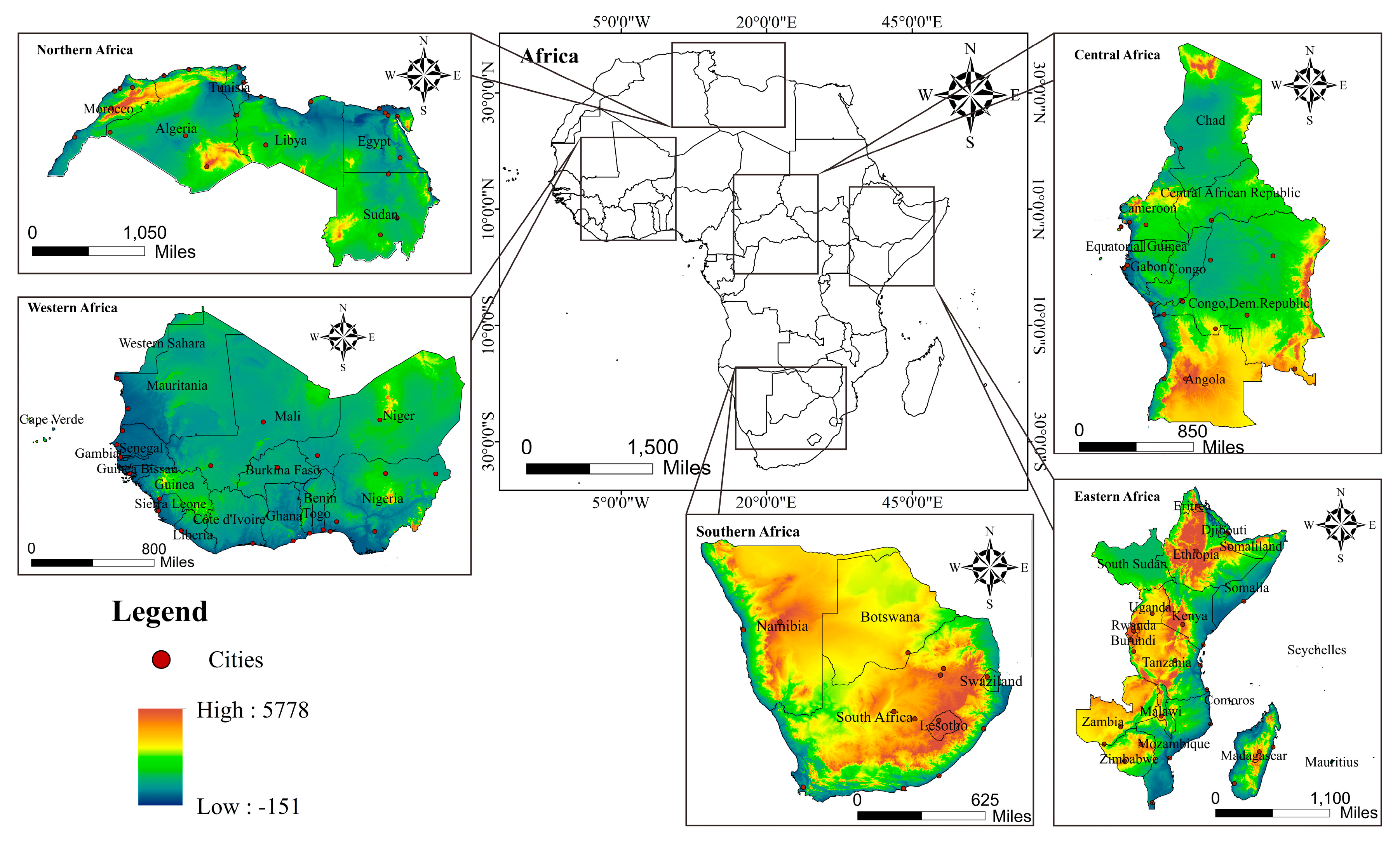
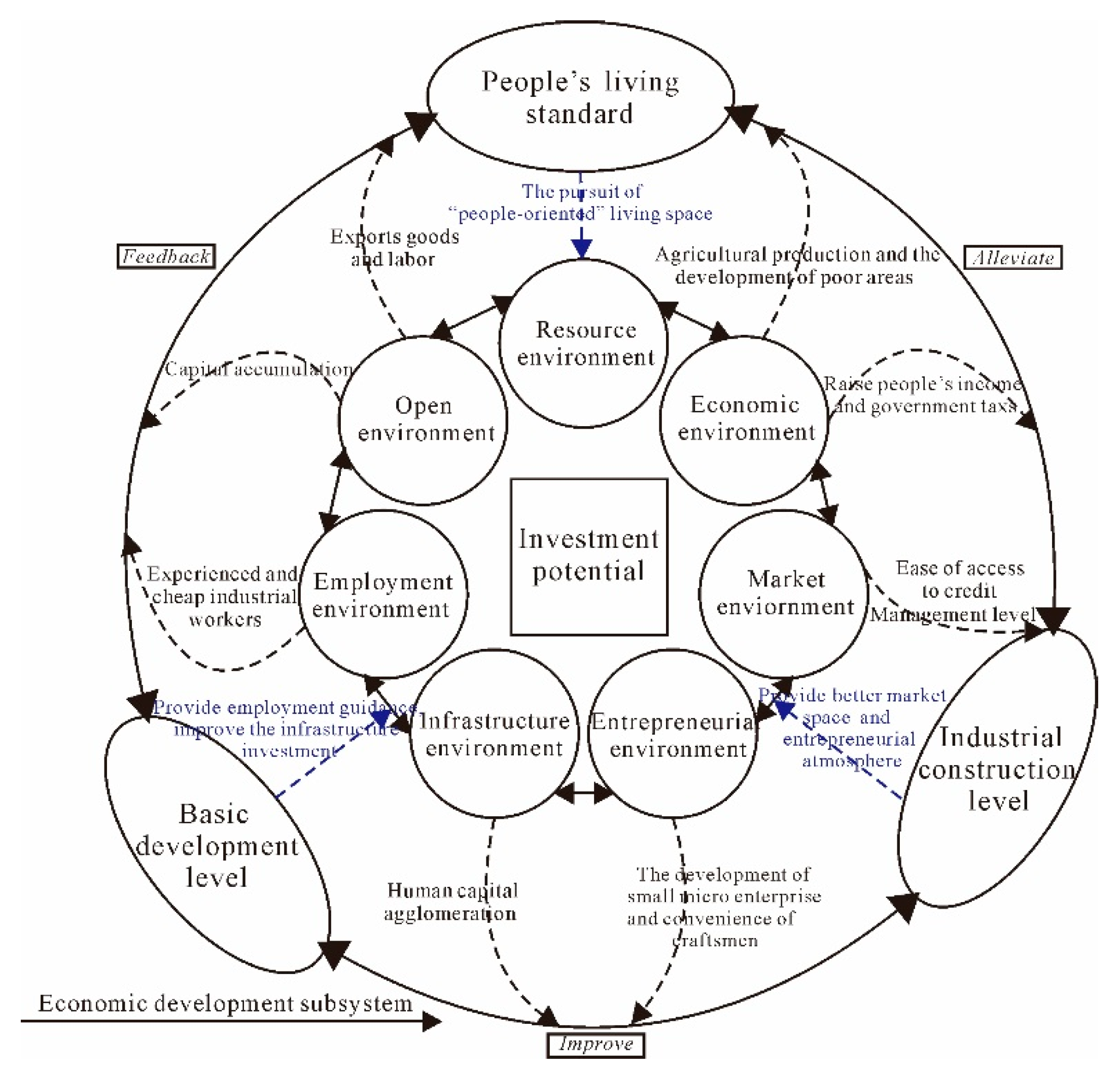
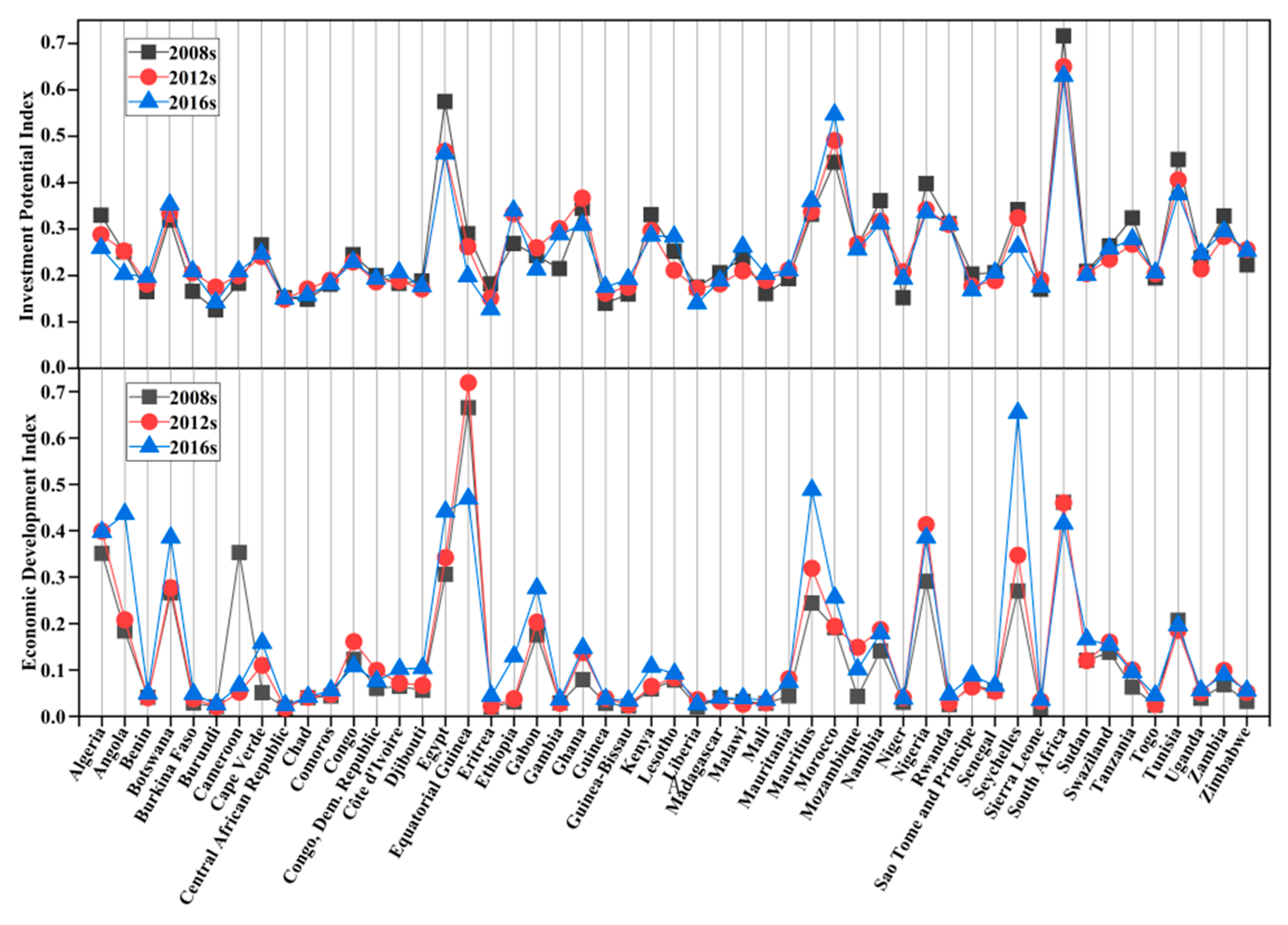
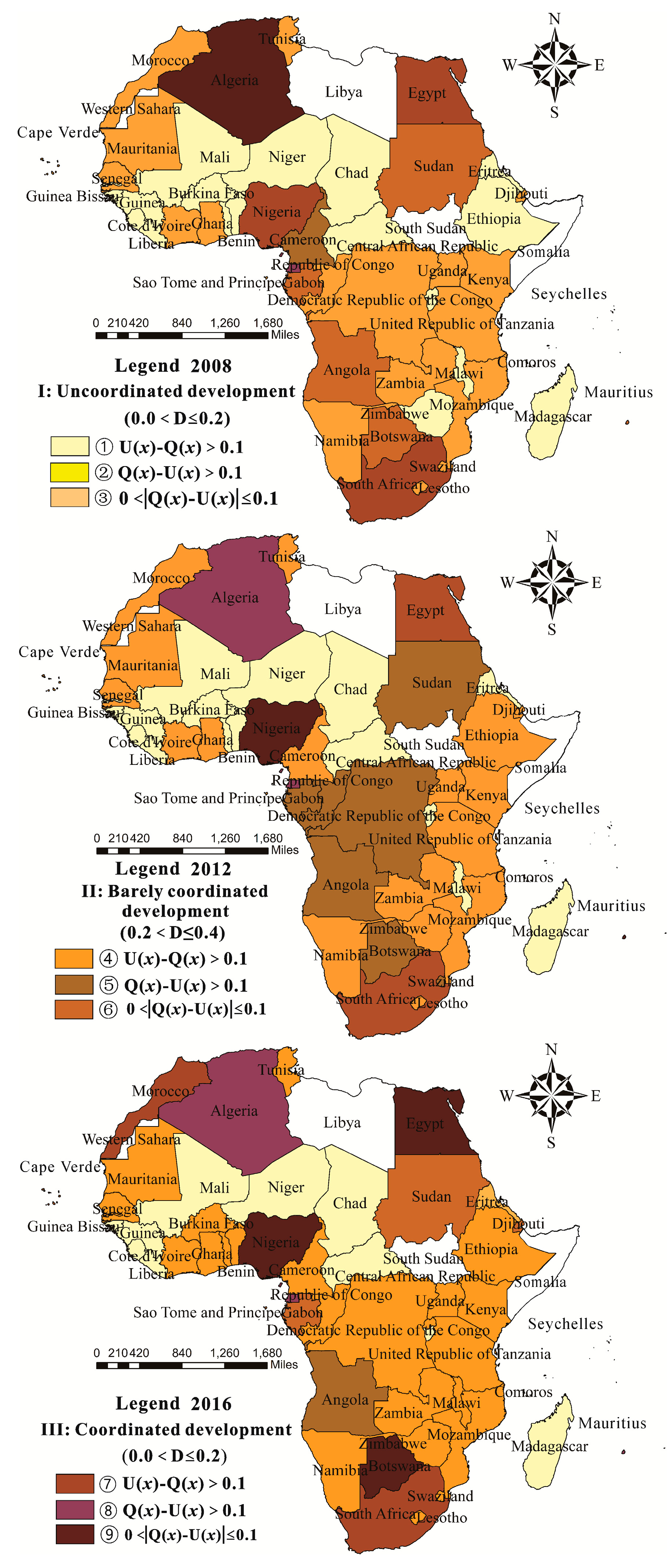
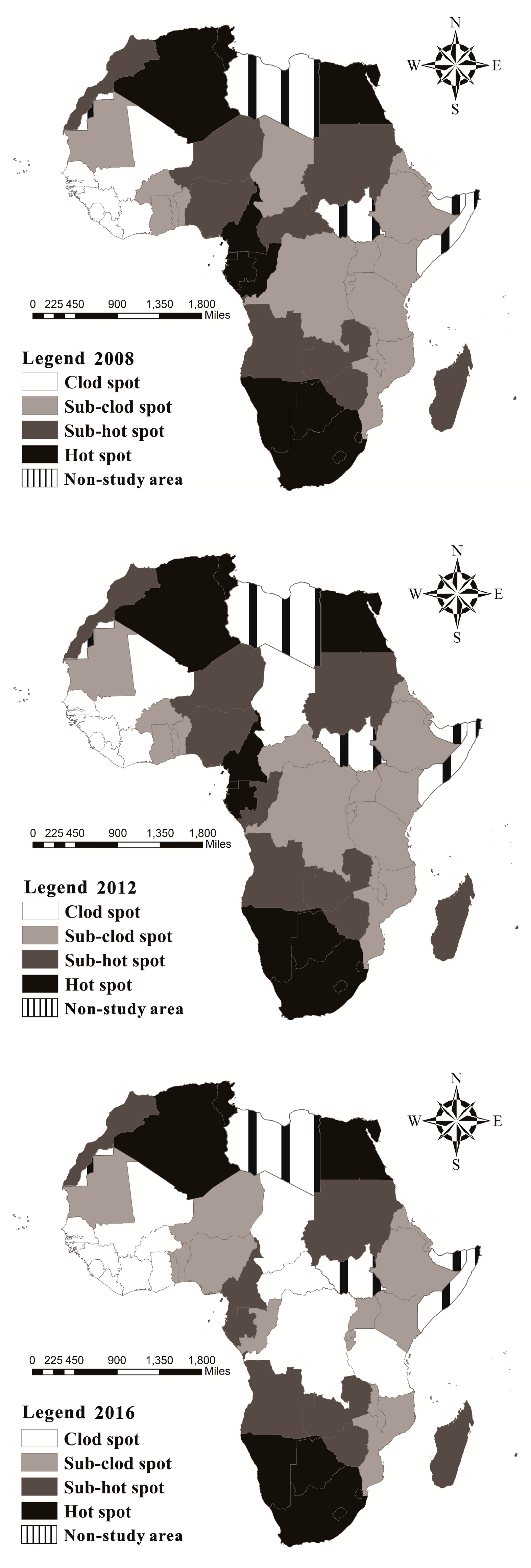

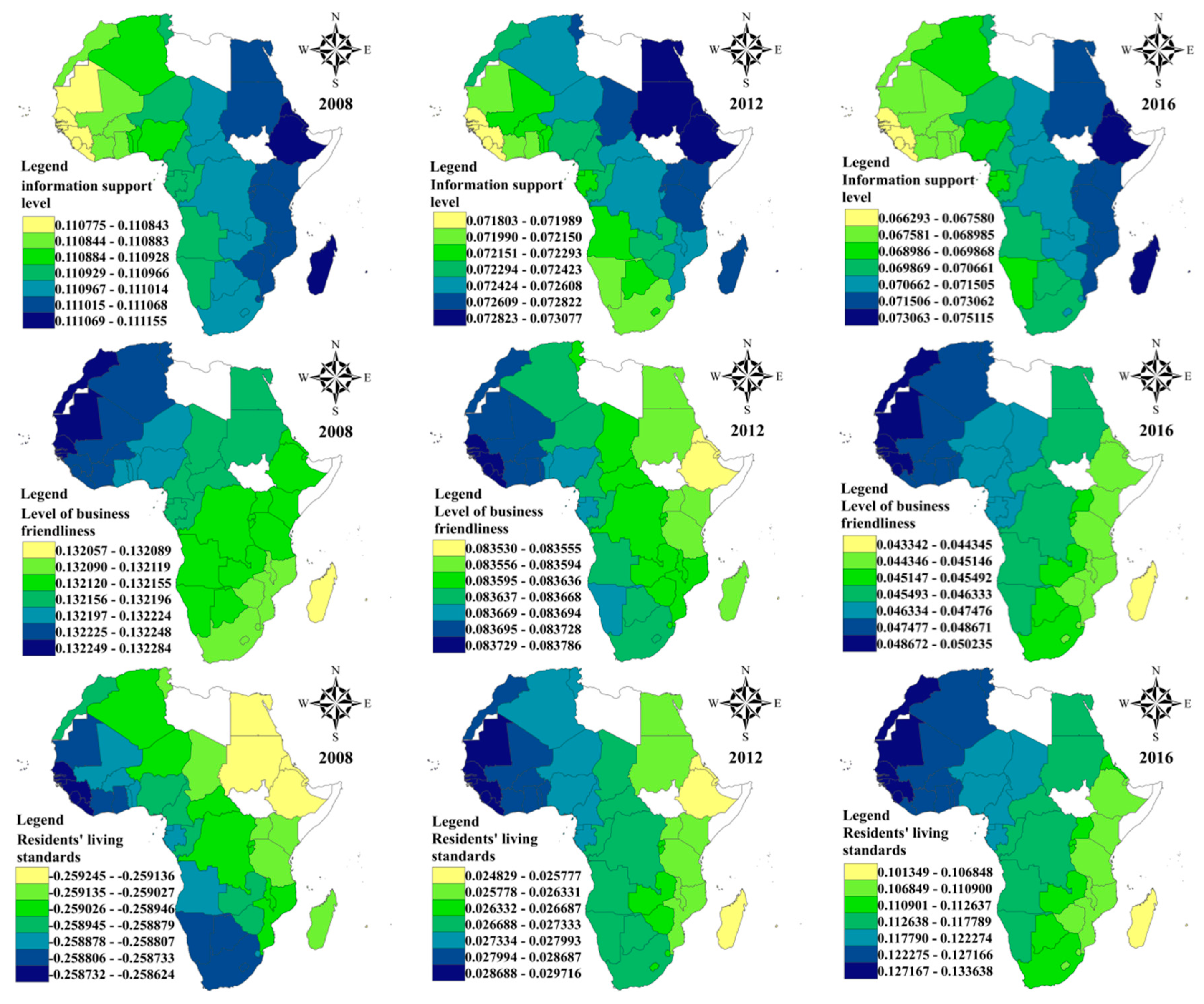
| System Layer | Subsystem Layer | Indicator Layer | Weight |
|---|---|---|---|
| Investment potential system | UQ: Resource endowment environment | UQ1 Per capita cultivated land area (Hectare/person) | 0.029 |
| UQ2 Proportion of urban population to the total population (%) | 0.024 | ||
| UQ3 Economically active population (Thousand people) | 0.087 | ||
| UT: Economic development environment | UT1 GDP growth rate (%) | 0.011 | |
| UT2 Total value of fixed assets formation (Million dollars) | 0.187 | ||
| UT3 ·Annual growth rate of inflation calculated by CPI (%) | 0.006 | ||
| UT4 Proportion of industrial production to GDP (%) | 0.033 | ||
| UI: Market healthy environment | UI1 Contract execution index (-) | 0.038 | |
| UI2 Unit container export cost (USD) | 0.007 | ||
| UI3 Easy access to credit (-) | 0.034 | ||
| UP: Entrepreneurial friendly environment | UP1 Government expenditure as a share of GDP (%) | 0.023 | |
| UP2 Investor protection ease (-) | 0.033 | ||
| UP3 Business environment index (-) | 0.044 | ||
| UP4 Ease of licensing (-) | 0.038 | ||
| UE: Infrastructure construction environment | UE1 Number of visitors arriving (Thousand people) | 0.135 | |
| UE2 Teacher-student ratio in primary schools (%) | 0.019 | ||
| UE3 Number of hospital beds per 10,000 people (Quantity) | 0.087 | ||
| UE4 Number of mobile cellular subscribers per 1000 inhabitants (Quantity) | 0.024 | ||
| UF: Opening to the outside environment | UF1 Cross-border trade index (-) | 0.043 | |
| UF2 The total export value of goods and services accounts for the proportion of GDP (%) | 0.027 | ||
| UF3 Total import and export as a percentage of GDP (%) | 0.022 | ||
| UK: Employment environment | UK1 Labor force participation rate over 15 years old (%) | 0.021 | |
| UK2 ·Adult illiteracy rate (%) | 0.016 | ||
| UK3 ·Total unemployment rate (%) | 0.010 | ||
| Economic development system | QT: Basic development level | QT1 GDP (Million dollars) | 0.163 |
| QT2 Per capita national reserve (USD) | 0.175 | ||
| QT3 Government revenue as a percentage of GDP (%) | 0.026 | ||
| QI: Industrial construction level | QI1 Per capita manufacturing value added (USD/person) | 0.158 | |
| QI2 Agricultural added value as a share of GDP (%) | 0.011 | ||
| QI3 FDI inflow stock (Million dollars) | 0.141 | ||
| QP: People’s living standards | QP1 Per capita GNI (USD/person) | 0.108 | |
| QP2 Per capita domestic savings (USD/person) | 0.131 | ||
| QP3 ·Per capita private consumption expenditure (%) | 0.089 |
| Investment Potential Index | Economic Development Index | |||||
|---|---|---|---|---|---|---|
| 2008 | 2012 | 2016 | 2008 | 2012 | 2016 | |
| AVG | 0.259 | 0.255 | 0.252 | 0.116 | 0.13 | 0.151 |
| CV | 0.437 | 0.379 | 0.386 | 1.152 | 1.094 | 1.025 |
| SD | 0.112 | 0.097 | 0.097 | 0.133 | 0.142 | 0.155 |
| Uncoordinated Development | Barely Coordinated Development | Coordinated Development | |||||||
|---|---|---|---|---|---|---|---|---|---|
| 2008 | 2012 | 2016 | 2008 | 2012 | 2016 | 2008 | 2012 | 2016 | |
| Total | 20 | 17 | 11 | 26 | 27 | 31 | 5 | 7 | 9 |
| Percentage (%) | 39.22 | 33.33 | 21.57 | 50.98 | 52.94 | 60.78 | 9.80 | 13.73 | 17.65 |
| RLOED (①④⑦) | 20 | 17 | 10 | 19 | 20 | 25 | 3 | 2 | 2 |
| RLOIP (②⑤⑧) | 0 | 0 | 0 | 1 | 0 | 1 | 1 | 2 | 4 |
| RB (③⑥⑨) | 0 | 0 | 1 | 6 | 7 | 5 | 1 | 3 | 3 |
| Driving Factors | Indicators for Explaining the Driving Factor | Meaning of Indicators | P2008 | P2012 | P2016 |
|---|---|---|---|---|---|
| X1 EBL | per capita GDP | National macroeconomic operating state | 0.6568 | 0.7683 | 0.8124 |
| X2 ICL | The added value of the secondary industry and service sector accounted for the proportion of GDP | The dominant position of the industrial economy | 0.4859 | 0.4347 | 0.3903 |
| X3 DU | Urbanization rate | Urban scale and level of urban development | 0.2643 | 0.2148 | 0.1030 |
| X4 ISL | Number of mobile cellular phone users per 1000 inhabitants | The application of modern information technology | 0.4450 | 0.4305 | 0.4013 |
| X5 LBF | Ease of doing business index | National support for various business activities | 0.3260 | 0.2812 | 0.2767 |
| X6 RLS | Per capita GNI | Basic living standards and consumption capacity of the residents | 0.7137 | 0.7722 | 0.7315 |
| X7 GSL | Proportion of fiscal expenditure to GDP | Government’s ability to support the operation of the national economy | 0.0925 | 0.2459 | 0.1427 |
| Parameter | Years | ||
|---|---|---|---|
| 2008 | 2012 | 2016 | |
| Bandwidth | 93,666,588.12 | 44,340,087.96 | 12,967,325.55 |
| Residual squares | 0.1302 | 0.1220 | 0.1278 |
| Sigma | 0.0537 | 0.0521 | 0.0537 |
| AICc | −143.1478 | −146.4001 | −143.1496 |
| R2 | 0.7164 | 0.7232 | 0.7120 |
| Adjusted R2 | 0.6848 | 0.6921 | 0.6752 |
© 2020 by the authors. Licensee MDPI, Basel, Switzerland. This article is an open access article distributed under the terms and conditions of the Creative Commons Attribution (CC BY) license (http://creativecommons.org/licenses/by/4.0/).
Share and Cite
Wei, G.; Sun, P.; Zhang, Z.; Ouyang, X. The Coordinated Relationship between Investment Potential and Economic Development and Its Driving Mechanism: A Case Study of the African Region. Sustainability 2020, 12, 442. https://doi.org/10.3390/su12010442
Wei G, Sun P, Zhang Z, Ouyang X. The Coordinated Relationship between Investment Potential and Economic Development and Its Driving Mechanism: A Case Study of the African Region. Sustainability. 2020; 12(1):442. https://doi.org/10.3390/su12010442
Chicago/Turabian StyleWei, Guoen, Pingjun Sun, Zhenke Zhang, and Xiao Ouyang. 2020. "The Coordinated Relationship between Investment Potential and Economic Development and Its Driving Mechanism: A Case Study of the African Region" Sustainability 12, no. 1: 442. https://doi.org/10.3390/su12010442
APA StyleWei, G., Sun, P., Zhang, Z., & Ouyang, X. (2020). The Coordinated Relationship between Investment Potential and Economic Development and Its Driving Mechanism: A Case Study of the African Region. Sustainability, 12(1), 442. https://doi.org/10.3390/su12010442








